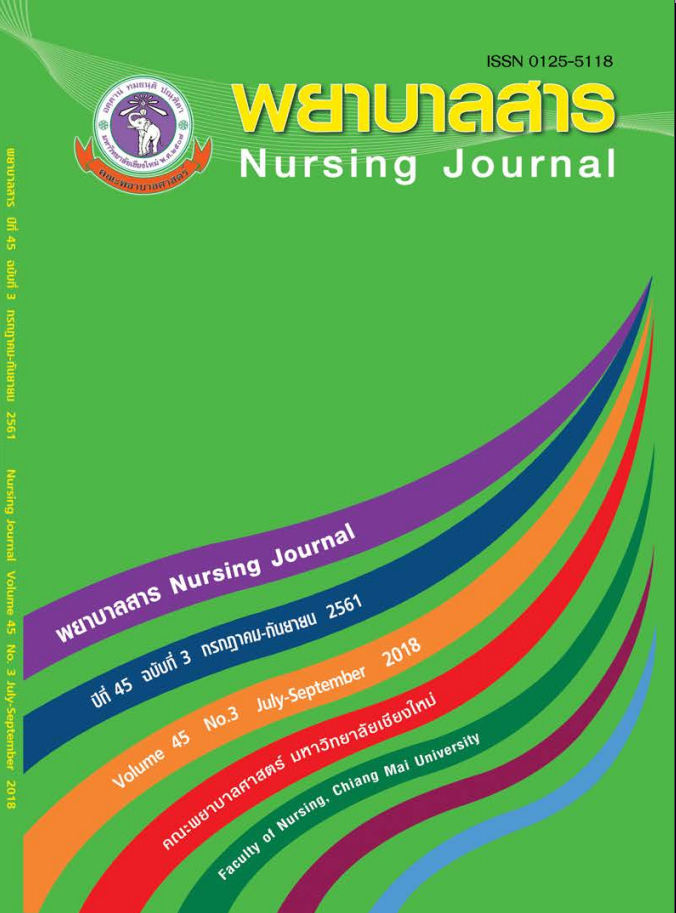ความสุภาพของพยาบาลวิชาชีพตามการรับรู้ของนักศึกษาพยาบาล คณะพยาบาลศาสตร์ มหาวิทยาลัยเชียงใหม่
คำสำคัญ:
ความสุภาพ, พยาบาลวิชาชีพ, นักศึกษาพยาบาลบทคัดย่อ
ความสุภาพของพยาบาลวิชาชีพมีความสำคัญต่อการเรียนรู้ของนักศึกษาพยาบาลในการฝึกปฏิบัติงานทางคลินิก การศึกษาเชิงพรรณนาครั้งนี้มีวัตถุประสงค์เพื่อศึกษาความสุภาพของพยาบาลวิชาชีพตามการรับรู้ของนักศึกษาพยาบาล คณะพยาบาลศาสตร์ มหาวิทยาลัยเชียงใหม่ กลุ่มตัวอย่างเป็นนักศึกษาพยาบาลชั้นปีที่ 2 จำนวน 134 คน รวบรวมข้อมูลตั้งแต่เดือนสิงหาคมถึงเดือนกันยายน พุทธศักราช 2560 เครื่องมือที่ใช้ในการศึกษาคือ แบบสอบถามความสุภาพของพยาบาลวิชาชีพ ที่ผู้ศึกษาดัดแปลงจากแบบประเมินการรับรู้ของนักศึกษาพยาบาลเกี่ยวกับความสุภาพและความไม่สุภาพในสภาพแวดล้อมการเรียนรู้ทางคลินิกของเทคซาและคณะ ผ่านการตรวจสอบความตรงตามเนื้อหาโดยผู้ทรงคุณวุฒิ ได้ค่าดัชนีความตรงตามเนื้อหาเท่ากับ 1 และทดสอบความเชื่อมั่นของแบบสอบถามได้ค่าเท่ากับ 0.91 วิเคราะห์ข้อมูลโดยใช้สถิติเชิงพรรณนา
ผลการศึกษาพบว่า ความสุภาพของพยาบาลวิชาชีพตามการรับรู้ของนักศึกษาพยาบาลโดยรวมอยู่ในระดับสูง ( = 3.22; SD = 0.39) เมื่อพิจารณารายด้านพบว่าความสุภาพด้านการเคารพให้เกียรติซึ่งกันและกันและด้านการมีส่วนร่วมแบบชี้นำอยู่ในระดับสูงมาก ( = 3.27; SD = 0.48, = 3.32; SD = 0.40 ตามลำดับ) ส่วนด้านการยึดผู้เรียนเป็นศูนย์กลางอยู่ในระดับสูง ( = 3.04; SD = 0.45)
ผลการศึกษาครั้งนี้ ผู้บริหารการศึกษาทางการพยาบาลสามารถใช้เป็นข้อมูลในการวางแผนจัดการศึกษาภาคปฏิบัติที่เอื้อให้เกิดการเรียนรู้อย่างมีประสิทธิภาพของนักศึกษาพยาบาลต่อไป
เอกสารอ้างอิง
nursing student burnout. International Journal of Nursing Education Scholarship, 11(1),
145-154.
Becker, M. K. & Neuwirth, J. N. (2002). Teaching strategy to maximize clinical experience with
beginning nursing students. Journal of Nursing Education, 41(2), 89-91.
Bond, M. E. (2009). Exposing shame and its effect on clinical nursing education. Journal of
Nursing Education, 48(30), 132-140.
Broadbent, M., Moxham, L., Sander, T., Walker, S., & Dwyer, T. (2014). Supporting bachelor of nursing
students within the clinical environment: Perspectives of preceptors. Nurse Education in Practice, 14(4), 403–409.
Clark, C. M. (2013). Creating & sustaining civility in nursing education. Indianapolis, IN:
Sigma Theta Tau International.
Clark, C. M., Farnsworth, J., & Landrum, R. E. (2009). Development and Description of the
Incivility in Nursing Education (INE) Survey. Journal of Theory Construction & Testing, 13(1),
7-15.
Clark, C. M., Nguyen, D. T., & Barbosa-Leiker, C. (2014). Student Perceptions of Stress, Coping, Relationships, and Academic Civility. Nurse Educator, 39(4), 170–174.
Clark, C. M., & Springer, P. J. (2007). Incivility in nursing education: A descriptive study on
definitions and prevalence. Journal of nursing education, 47, 7-14.
Duffy, J. R. (2013). Quality caring in nursing and health systems: implications for clinicians,
educators, and leaders, 2nd edition. New York: Springer Publishing Company.
Faculty of Nursing, Chiang Mai University. (2016). Bachelor of Nursing Science Program 2015.
Chiang Mai: Faculty of Nursing, Chiang Mai University.
Furguson, A. M. C. (2000). The student experience of preceptorship in nursing: learning through
guided participation. Retrieved August, 20, 2017 from http://hdl.handle.net/1842/22204
Jones, H. S. (2010). Nursing Student’s perceptions of working with staff nurses. Journal of
Chemical Information and Modeling, 53(April), https://doi.org/10.1017/CBO9781107415324.004
Krejcie, R. V. & Morgan, D. W. (1970). Determining Sample Size for Research Activities.
Educational and Psychological Measurement, 30(3), 607-610
Lertsakornsiri, M. (2014). The relationships between selected factors and nursing students’ learning
outcome in maternal-newborn and midwifery nursing practicum I at Saint Louis College. Journal of The Royal Thai Army Nurses, 15(3), 321-330.
Namakankham, A., Suvanayos, C., Pakpoom, P., & Poomcome, W. (2008). Stress and factors inducing
stress in nursing students during nursing practice on wards. Nursing Journal, 35(2), 26-36.
Roongruangsri, S., & Sngounsiritham, U. (2015). Civility and social etiquette in nursing students leading
to successful in workplace. Nursing Journal, 42(sppl.), 149-155.
Sundler, A. J., Björk, M., Bisholt, B., Ohlsson, U., Engström, A. K., & Gustafsson, M. (2014).
Student nurses’ experiences of the clinical learning environment in relation to the organization of supervision: A questionnaire survey. Nurse Education Today, 34(4), 661–666.
Tecza, B. M., Boots, B. K., Clay, P. M., Kirkman, K. S., Mains, B. C., Newton, E. E., Olney, A.,
... Bartlett, J. A. (2015). Development of an instrument to measure civil and uncivil behaviors in the hospital clinical environment. Journal of Nursing Administration, 45(7/8), 391-397.
Thailand Nursing and Midwifery Council. (2017). Code of ethics. Retrieved June, 12, 2016 from http://www.tnc.or.th/law/page-4.html
Thomas, S.P. & Burk, R. (2009). Junior nursing students’ experiences of vertical violence during
clinical rotations. Nursing Outlook, 57, 226-231.
Woodworth, J. A. (2016). Promotion of nursing student civility in nursing education: a concept
analysis. Nursing forum, 51(3), 196-203.
ดาวน์โหลด
เผยแพร่แล้ว
รูปแบบการอ้างอิง
ฉบับ
ประเภทบทความ
สัญญาอนุญาต
บทความที่ได้รับการตีพิมพ์เป็นลิขสิทธิ์ของวารสารพยาบาลสาร
ข้อความที่ปรากฏในบทความแต่ละเรื่องในวารสารวิชาการเล่มนี้เป็นความคิดเห็นส่วนตัวของผู้เขียนแต่ละท่านไม่เกี่ยวข้องกับมหาวิทยาลัยเชียงใหม่ และคณาจารย์ท่านอื่นๆในมหาวิทยาลัยฯ แต่อย่างใด ความรับผิดชอบองค์ประกอบทั้งหมดของบทความแต่ละเรื่องเป็นของผู้เขียนแต่ละท่าน หากมีความผิดพลาดใด ๆ ผู้เขียนแต่ละท่านจะรับผิดชอบบทความของตนเองแต่ผู้เดียว






